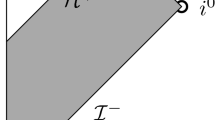Abstract
A fundamental conjecture in general relativity asserts that the domain of outer communication of a regular, stationary, four dimensional, vacuum black hole solution is isometrically diffeomorphic to the domain of outer communication of a Kerr black hole. So far the conjecture has been resolved, by combining results of Hawking [17], Carter [4] and Robinson [28], under the additional hypothesis of non-degenerate horizons and real analyticity of the space-time. We develop a new strategy to bypass analyticity based on a tensorial characterization of the Kerr solutions, due to Mars [24], and new geometric Carleman estimates. We prove, under a technical assumption (an identity relating the Ernst potential and the Killing scalar) on the bifurcate sphere of the event horizon, that the domain of outer communication of a smooth, regular, stationary Einstein vacuum spacetime of dimension 4 is locally isometric to the domain of outer communication of a Kerr spacetime.
Similar content being viewed by others
References
Beig, R., Simon, W.: The stationary gravitational field near spatial infinity. Gen. Relativ. Gravitation 12(12), 1003–1013 (1980)
Beig, R., Simon, W.: On the multipole expansion for stationary space-times. Proc. R. Soc. Lond., Ser. A 376(1765), 333–341 (1981)
Buntingand, G., Massood ul Alam, A.K.M.: Non-existence of multiple black holes in asymptotically Euclidean static vacuum space-time. Gen. Relativ. Gravitation 19, 147–154 (1987)
Carter, B.: An axy-symmetric black hole has only two degrees of freedom. Phys. Rev. Lett. 26, 331–333 (1971)
Carter, B.: Has the black hole equilibrium problem been solved? In: The Eighth Marcel Grossmann meeting, Part A, B (Jerusalem, 1997), pp. 136–155. World Sci. Publ., River Edge, NJ (1999)
Chandrasekhar, S.: The Mathematical Theory of Black Holes. Int. Ser. Monogr. Phys., vol. 69. Oxford Science Publications, The Clarendon Press, Oxford University Press, New York (1983)
Christodoulou, D., Klainerman, S.: The Global Nonlinear Stability of the Minkowski Space. Princeton Math. Ser., vol. 41. Princeton University Press, Princeton, NJ (1993)
Chrusciel, P.T.: On completeness of orbits of Killing vector fields. Classical Quantum Gravity 10, 2091–2101 (1993). arXiv:gr-qc/9304029
Chrusciel, P.T.: “No hair” theorems – folclore, conjecture, results. In: Beem, J., Duggal, K.L. (eds.): Differential Geometry and Mathematical Physics. Contemp. Math., vol. 170, pp. 23–49. Am. Math. Soc., Providence, RI (1994). arXiv:gr-qc/9402032
Chrusciel, P.T.: Uniqueness of stationary, electro-vaccum black holes revisited. Journees Relativistes 96, Part II (Ascona, 1996). Helv. Phys. Acta 69, 529–552 (1996). arXiv:gr-qc/9610010
Chrusciel, P.T.: The classification of static vacuum space-times containing an asymptotically flat space-like hypersurface with compact interior. Classical Quantum Gravity 16, 661–687 (1999). arXiv:gr-qc/9809088
Chrusciel, P.T., Delay, T., Galloway, G., Howard, R.: Regularity of horizon and the area theorem. Ann. Inst. Henri Poincaré 2, 109–178 (2001). arXiv:gr-qc/0001003
Chrusciel, P.T., Wald, R.M.: On the topology of stationary black holes. Classical Quantum Gravity 10, 2091–2101 (1993)
Chrusciel, P.T., Wald, R.M.: Maximal hypersurfaces in AF space-times. Commun. Math. Phys. 163, 561–164 (1994)
Friedrich, H., Racz, I., Wald, R.: On the rigidity theorem for spacetimes with a stationary event horizon or a compact Cauchy horizon. Commun. Math. Phys. 204, 691–707 (1999)
Friedman, J.L., Schleich, K., Witt, D.M.: Topological censorship. Phys. Rev. Lett. 71, 1846–1849 (1993)
Hawking, S.W., Ellis, G.F.R.: The Large Scale Structure of Space-time. Cambridge University Press, London, New York (1973)
Hörmander, L.: The Analysis of Linear Partial Differential Operators IV. Fourier Integral Operators. Grundlehren Math. Wiss., vol. 275. Springer, Berlin (1985)
Ionescu, A., Klainerman, S.: Uniqueness results for ill posed characteristic problems in curved space-times. Preprint (2007). arXiv:0711.0042
Isenberg, J., Moncrief, V.: Symmetries of cosmological Cauchy horizons. Commun. Math. Phys. 89, 387–413 (1983)
Israel, W.: Event horizons in static vacuum space-times. Phys. Rev. Lett. 164, 1776–1779 (1967)
Klainerman, S., Nicolò, F.: The Evolution Problem in General Relativity. Progr. Math. Phys., vol. 25. Birkhäuser, Boston, MA (2003)
Kobayashi, S.: Transformations Groups in Differential Geometry. Springer, New York, Heidelberg (1972)
Mars, M.: A spacetime characterization of the Kerr metric. Classical Quantum Gravity 16, 2507–2523 (1999)
Mars, M.: Uniqueness properties of the Kerr metric. Classical Quantum Gravity 17, 3353–3373 (2000)
Newman, E.T., Penrose, R.: An approach to gravitational radiation by a method of spin coefficients. J. Math. Phys. 3, 566–578 (1962)
Racz, I., Wald, R.: Extensions of space-times with Killing horizons. Classical Quantum Gravity 9, 2463–2656 (1992)
Robinson, D.C.: Uniqueness of the Kerr black hole. Phys. Rev. Lett. 34, 905–906 (1975)
Simon, W.: Characterization of the Kerr metric. Gen. Relativ. Gravitation 16, 465–476 (1984)
Sudarski, D., Wald, R.M.: Mass formulas for stationary Einstein Yang–Mills black holes and a simple proof of two staticity theorems. Phys. Rev. D 47, 5209–5213 (1993). arXiv:gr-qc/9305023
Author information
Authors and Affiliations
Corresponding author
Rights and permissions
About this article
Cite this article
Ionescu, A., Klainerman, S. On the uniqueness of smooth, stationary black holes in vacuum. Invent. math. 175, 35–102 (2009). https://doi.org/10.1007/s00222-008-0146-6
Received:
Accepted:
Published:
Issue Date:
DOI: https://doi.org/10.1007/s00222-008-0146-6



